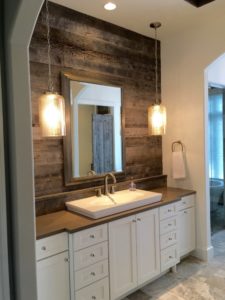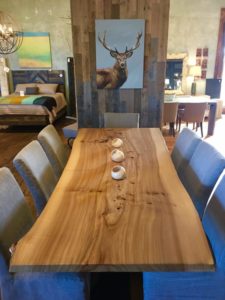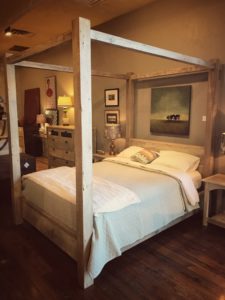Old Items, New Look
Transform your space with salvaged architectural pieces
Architectural salvage is the artful reuse of historic elements that were once part of an old structure. By incorporating them into a new space, these pieces can create a unique statement in a home. When an aged object or material that was destined for the dump or demolishment is looked at with a fresh perspective, restoration becomes its new path.
Reclaimed items can be found almost anywhere – from lumber supply stores and antique shops to the roadside or even in your own home. They can be small (like a Victorian-era doorknob) or large (like a wooden beam salvaged from an old barn). While a piece’s history may be unknown, it is ultimately transformed as it contributes to its new home’s evolving history.
Benefits of Salvage
When compared to newer pieces, reclaimed pieces often function as more durable products. As they age, they gain more character because they were not cheaply reproduced. Urban Evolutions in Appleton salvages materials throughout the U.S. from both barns and factories. In Wisconsin, Urban Evolutions has reclaimed an abundance of pine wood from barns, as well as maple and oak which is used for flooring and made into furniture like coffee tables and cabinets.
Furniture made of reclaimed material is especially functional with young children in a household as it already has nicks and is weathered. Joseph Amann, director of sales at Urban Evolutions, says, “It’s not like a brand new car with a dent. It’s a piece of wood that you’re adding [character] to.”
Salvaged pieces also offer a more unique look, because they are recycled pieces of history. Architectural pieces are authentic markers of history that become preserved when salvaged. Many homeowners appreciate the one-of-a-kind feel they create in a home.
Reusing salvaged materials is sustainable not only historically, but also environmentally. Repurposing items that were going to be thrown away reduces waste and spreads information about being resourceful. Homeowners are able to gain useful skills on how to utilize architectural items in numerous ways.
“Generations are saving not only graceful old things, but graceful old knowledge about skills used with these things that are getting lost and are worth knowing,” says Nicole Roost, co-owner of Saving Grace Salvage Company in Berlin.
Salvage Trends
Crescent Moon Antiques & Salvage in Oshkosh offers reclaimed wood materials and larger architectural pieces, but it also focuses on smaller decorative elements as well. Along with farms and factories, co-owners Julie and J Karner get called to salvage items from an array of places like churches, schools and historic homes before they are demolished.
Repurposing items from public spaces in private homes is a growing trend. Homeowners are utilizing items from churches such as shelves off the back of pews as well as stained glass and religious paintings. They are also incorporating large sheets of slate, or chalkboard, from old schools as backsplashes, countertops, walls and floors.
One popular trend is using antique exterior windows in newly constructed interior walls. Julie Karner says, “[These windows] create visual interest and allow light to pass from room to room.”
For homeowners who embrace a little quirk, taxidermy gone wrong is a cheeky new trend. (Google “bad taxidermy” for some hilarious examples.) While this trend is less architectural, it’s a whimsical way to add personality and humor to your home. “For some people, the stranger, the better,” Roost says.
Beam and Board Reclaimed Lumber in Green Bay focuses on salvaging different types of wood with 80 percent coming from over 100-year-old Wisconsin barns. This wood can be used in any part of the house such as a mantel, ceiling beams or a bed’s headboard. “We salvage as much as we can,” says Terry Anderson, sales manager at Beam and Board. “The rest of it is brought back and if we can’t use it we burn it for fuel for our kiln. So very little of it goes to waste.”
Many homeowners are combining reclaimed wood with a cleaner, often times metal, look on furniture. Reusing windows and sliding doors from barns while also using a barn’s old machinery parts for decoration is another hot trend.
“We have started to bring in some of the old machinery items, we call them ‘barntiques,’” Anderson says. “We never did that in the past, it wasn’t a focus of ours. But we’re starting to get more and more people who are interested in these objects.”
_________________________________________________________________________
Salvage like a Pro
Tips for incorporating architectural salvage pieces in your home
- Budget time and money accordingly. The amount of work that goes into authentic reclaimed items often makes them pricier and the wait longer.
- Look at pieces in a different light. “Just because it was one thing before, doesn’t mean it has to be that thing anymore,” says Brad Roost, co-owner of Saving Grace Salvage Company.
- Start by incorporating only one salvaged piece like a table, bed or mirror and build from there. The rest of the house doesn’t have to change right away.
- Visit showrooms in person to see and touch reclaimed materials. This is more helpful than looking at pictures.
- Mixing textures and colors is in, matching is out. “It’s a thing of the past,” Amann says. “Wood will pop out in a distinct way with different materials compared to matching ones.”
- Ask for help. Workers in the salvage industry enjoy being challenged creatively.
- Take your time when choosing items. Pick items that you love and that might spark fond memories. J Karner, co-owner of Crescent Moon Antiques & Salvage says, “Only focus on the ‘what.’ The ‘how’ will reveal itself.”














Leave a Comment